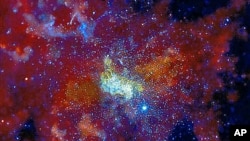Britain-based astronomers say there is new evidence to suggest the supermassive black hole at the center of our Milky Way galaxy is consuming a steady daily diet of asteroids it has stripped away from their parent stars.
The University of Leicester scientists say the findings would help explain the bright flares that erupt from the Milky Way’s central black hole about once per day. They conducted their study with data collected by the U.S. space agency’s [NASA’s] Chandra X-ray Observatory.
The scientists say their analysis of the Chandra data suggests the Milky Way’s black hole, known as Sagittarius-A, is surrounded by a huge cloud containing trillions of asteroids and comets captured by the black hole's powerful gravitational forces.
The researchers estimate that any asteroid passing within about 160 million kilometers of Sagittarius-A likely would meet the gruesome fate of being torn apart and vaporized as it is pulled into the black hole's inescapable void. The friction that occurs during the violent vaporization process generates the flare.
The scientists say asteroids measuring at least 10 kilometers across would be large enough to cause the type of X-ray flares Chandra observed. The flares last for a few hours with a level of brightness that ranges from a few times to nearly 100 times greater than the black hole's regular output.
The University of Leicester scientists calculate the Sagittarius-A black hole probably has gobbled up trillions of asteroids during its 10-billion-year life span.
The new study is published in the journal, Nature.
In general, astronomers believe there is a black hole at the center of almost all galaxies in the universe. These monstrous galactic phenomena - known as supermassive black holes - are many billions of times the mass of the Sun.
The gravity of any black hole is so strong that nothing can escape, not even light.









